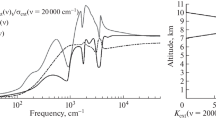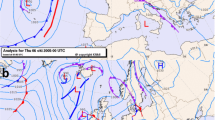Abstract
A conductive-radiative model is used to predict the formation and growth of radiation fog. This is accomplished by solving numerically the heat and mass transport equations in conjunction with an approximate form of the radiative transfer equation. The equations of motion in simplified form are included in the physical system to make use of Blackadar's (1962) formulation of the exchange coefficient of the boundary layer.
It is found for a number of hypothetical test cases that the model gives results which appear to represent real physical conditions. One actual situation is tested. Results show that the model reproduces better than qualitatively those parameters which are obtained from routine observations.
Similar content being viewed by others
References
Best, A. C.: 1951, ‘Drop-size Distribution in Cloud and Fog’,Quart. J. R. Meteor. Soc. 77, 418.
Blackadar, Alfred K.: 1962, ‘The Vertical Distribution of Wind and Turbulent Exchange in a Neutral Atmosphere’,J. Geophys. Res. 67, 3095–3102.
Deirmendjian, D.: 1969,Electromagnetic Scattering on Spherical Polydispersions, New York, American Elsevier Publ. Co., 79–83.
Diem, M.: 1948, ‘Messungen der Grösse von Wolkenelementen II’,Meteor. Rundschau 1, 261–273.
Estoque, M. A.: 1963, ‘A Numerical Model of the Atmospheric Boundary Layer’,J. Geophys. Res. 86, 1103–1113.
Feigel'son, E. M.: 1964,Light and Heat Radiation in Stratus Clouds, Transl. from Russian, U.S. Dept. of Commerce and National Science Foundation, Washington, D.C., Gov't Printing Office.
Fisher, E. L. and Caplan, P.: 1963, ‘An Experiment in Numerical Prediction of Fog and Stratus’,J. Atmos. Sci. 20, 425–437.
Korb, G. and Zdunkowski, W. G.: 1970, ‘Distribution of Radiative Energy in Ground Fog’,Tellus 22, 298–320.
Kraus, H.: 1958, ‘Untersuchungen über den nächtlichen Energietransport and Energiehaushalt in der bodennahen Luftschicht bei der Bildung von Strahlungsnebeln’,Ber. Dtsch. Wetterd., Nr. 48, 25 pp.
Kuhn, P. M.: 1963, ‘Radiometersonde Observations of Infrared Flux Emissivity of WaterVapor’,J. Appl. Meteor. 2, 368–378.
McDonald, J. E.: 1963, ‘The Saturation Adjustment in Numerical Modelling of Fog’,J. Atmos. Sci. 20, 476–478.
Möller, F.: 1943, ‘Das Strahlungsdiagramm’,Wissenschaftliche Abhandlungen des Deutschen Reiches, Wetterdienst, 16 pp.
Pandolfo, J. P., Cooley, D. S., and Atwater, M. A.: 1964,Further Investigations of Numerical Models of the Atmosphere Boundary Layer, Hartford, Conn., The Travelers Research Center, pp. 1–18.
Petterssen, S.: 1956,Weather Analysis and Forecasting, New York, McGraw-Hill, p. 24.
Radford, W. H.: 1938, ‘An Instrument for Sampling and Measuring Liquid Fog Water’,MIT Papers Phys. Oceanogr. Meteor. 6, 107.
Rodhe, B.: 1962, ‘The Effect of Turbulence on Fog Formation’,Tellus 14, 49–86.
Rodhe, B.: 1966, ‘The Concentration of Liquid Water in the Atmosphere’,Tellus 18, 86–104.
Wu, S. S.: 1965, ‘A Study of Heat Transfer Coefficients in the Lowest 400 Meters of the Atmosphere’,J. Geophys. Res. 70, 1801–1808.
Zdunkowski, W. G. and Johnson, F. G.: 1965, ‘Infrared Flux Divergence Calculations with Newly Constructed Radiation Tables’,J. Appl. Meteor. 4, 371–377.
Zdunkowski, W. G. and Nielsen, B. C.: 1969, ‘A Preliminary Prediction Analysis of Radiation Fog’,Pure and Appl. Geophys. 19, 45–66.
Zdunkowski, W. G. and Crandall, W. K.: 1971, ‘Radiative Transfer of Infrared Radiation in Model Clouds’,Tellus 6, 517–527.
Zdunkowski, W. G. and Trask, D. C.: 1971, ‘Application of a Radiative-Conductive Model to the Simulation of Nocturnal Temperature Changes over Different Soil Types’,J. Appl. Meteor. 10, 937–948.
Author information
Authors and Affiliations
Rights and permissions
About this article
Cite this article
Zdunkowski, W.G., Barr, A.E. A radiative-conductive model for the prediction of radiation fog. Boundary-Layer Meteorol 3, 152–177 (1972). https://doi.org/10.1007/BF02033916
Received:
Issue Date:
DOI: https://doi.org/10.1007/BF02033916




